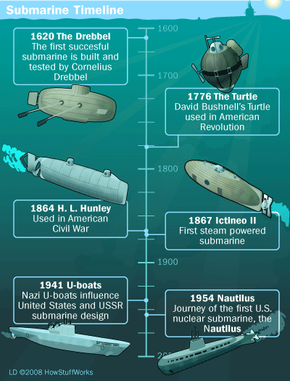Submarine Development in the 19th Century
Designs for a battery- and diesel-propelled submarine emerged in the years following the Civil War. In 1867, an important step was made with the successful launch of the world's first steam-powered submarine, the Ictineo II, created by Spain's Narcis Monturiol [source: Holian]. This development is notable because nuclear submarines are essentially steam-powered. (As we'll learn later, the main difference is that in nuclear submarines, the steam is created by superheating water using atomic fission. By contrast, in conventional steam engines, the power is created by burning coal.)
Before World War I, the United States focused its submarine fleet on coastal defense. The groundwork for the submarine race was laid at the turn of the century, as many features of future submarines were already in use. Engineers continued to tweak the designs of propellers, devised new systems for using water as ballast and the made strides toward the development of diesel-electric hybrid submarines. These subs were propelled on the surface using the diesel engine, and they went electric when submerged underwater. This combination saved valuable oxygen underwater and helped maintain the integrity of the air inside the submarine.
Advertisement
The United States realized that its submarine designs didn't compare favorably to those of other World War I combatants. In the decades between the World Wars, the U.S. reinvested in research and development, greatly improving the quality of its submarine fleet. One of the biggest improvements to U.S. submarines was that they were enabled to move at faster speeds that allowed them to accompany and protect naval fleets as they traveled across the world. The long-range fleet of U.S. submarines would later be responsible for bringing destruction to the Japanese fleet in the Pacific theater of war.
After World War II, both the U.S. and the Soviet Union studied the designs of the superior Nazi U-boats and altered their own submarines to mimic the U-boat. U-boats had a streamlined hull, which made them run faster than U.S. and USSR subs. They also utilized a snorkel, which was basically two tubes running between the submerged vessel and the surface. One tube brought air to the diesel engine and the other took foul air away. This allowed the submarine to remain submerged, even while the diesel engine was running.
In this postwar period, more streamlined and efficient diesel-electric subs emerged. Because of their low construction costs and stealthy silence, variants of those diesel-electric subs are still in use by navies worldwide today.
The U.S. Navy, however, was cooking up a bigger, bolder idea that would change naval strategy and tactics forever. You'll learn all about it in the next section.
